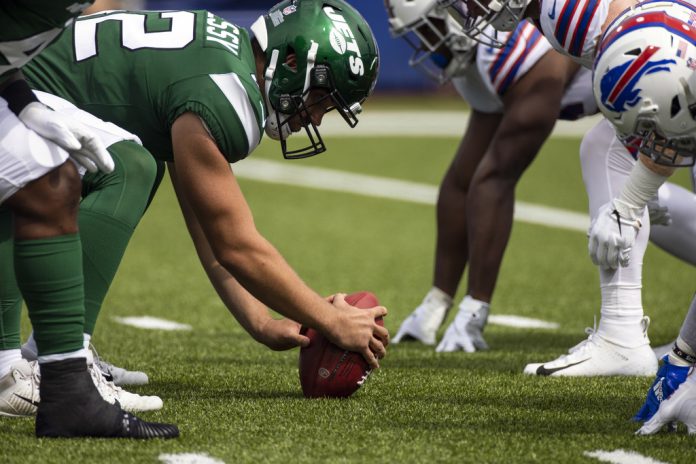FLORHAM PARK, N.J. (AP) — Thomas Hennessy’s journey to the NFL began with one big snap decision in high school.
The self-described “late bloomer” always had a pretty good arm, but playing quarterback didn’t seem realistic. Hennessy wanted to be part of Don Bosco Preparatory’s team in Ramsey, New Jersey, and contribute, even if it wasn’t as a starter.
So his father suggested he try his hand at long snapping.
“If you can throw overhand, you could probably figure out how to throw it underhand to do a long snap, and it’s something you just might have a knack for,” the New York Jets ‘ longest-tenured player recalled his father telling him. “So I gave it a try in ninth grade, just kind of in the backyard messing around.
“And it turned out, I did have a knack for it.”
He made the team, attended long snapper camps, played at Duke, was signed by Indianapolis as an undrafted free agent in 2017 and traded to the Jets a few months later. Hennessy, the older brother of Eagles center Matt Hennessy, has since become one of the NFL’s most consistent and reliable long snappers — a job that remains perhaps one of the most underappreciated in sports.
“It has gained more recognition over the years, but overall it is overlooked,” he said. “Just because of the nature of the position, the snap is taken for granted. … The 32 snappers across the league are so good that you expect every snap to be perfect.”
So, what does it take to be an NFL long snapper? Hennessy gave The Associated Press a step-by-step look:
The art
“It’s something that’s based on feel a lot,” Hennessy said. “The mentality going into each snap is being perfect, but becoming second nature where it’s something you don’t have to think about. I would say the approach to it is an art and I would say the actual skill is an art.”
The mentality
“I’m not good at golf, but I think it’s probably pretty similar to a golf shot where you’re just very focused on your routine so that things are second nature and you’re doing things the exact same way every time. And you make sure your setup is great because your setup is going to control how the rest of the play goes for you.”
Scanning the opponent
“On punts, specifically, you need to survey the rush and maybe have an idea of what concept they’re coming at you with. Are they going to rush you? How might the rush look? It’s not just you’re doing your own thing. You have to think about what the other team is going to do.”
Stance and grip
“The thing that makes it an art is that everyone does it a little differently. For me, you’re holding the ball like you’re going to throw it with your right hand — I’m a righty. Your left hand is on it lightly, like a guide hand, kind of like your guide hand is on a basketball free throw.
“You have a flat back and you’re bent at the knees so that you can get your hamstrings into it.”
The snap
“When you throw the snap, your arms are extended, but not fully extended. And then you’re just throwing it and following through to the target to generate rotation and spin and throw an accurate snap. Mechanically, at a basic level, that’s what it is.”
Punt vs. field goal
“The snaps are very similar, but the difference on field goals is the snap is a little lower because the target (the holder) is 8 yards away and the target is maybe a foot or two above the ground. With a punt, it’s like 3 or 4 feet above the ground at the punters’ belly button, approximately, 14 yards away.”
Snap rotation
“There’s extra focus on touch with the field goal because you want the laces to be forward. People ask how snappers can control the laces on field goals because ideally the holder just catches it and puts the laces down and they’re facing the goal post, which we call ‘12 o’clock laces.’ It’s throwing the same exact snap every time. I don’t hold the ball on the laces, just based on my rotations. I hold it on a certain panel. And that’s to get the laces out every time.”
Hennessy said the ideal snap time for a punt is between 0.65 and 0.75 seconds.
Snaps on field goals aren’t usually timed because the distance is so short. Instead, the entire operation is timed from the snap to the kick, with an ideal time of approximately 1.3 seconds.
Completing the play
On a field goal, the long snapper blocks defenders as the kick is being attempted.
On a punt, the long snapper completes his snap and then takes off down the field with his teammates to try to tackle the returner.
And the job is done. Until the next long snap.
“It’s really fun to snap and protect, and coverage is kind of seen as a bonus for a long snapper, although several long snappers are getting more athletic and influencing the return more,” Hennessy said. “It’s really cool to be so specialized in snap and block, which is super and not many people can do that. But then to cover, just like another linebacker or tight end or running back, that’s a really cool thing that you turn into just a full-on football player.”
___
AP NFL: https://apnews.com/hub/nfl
Source: post





